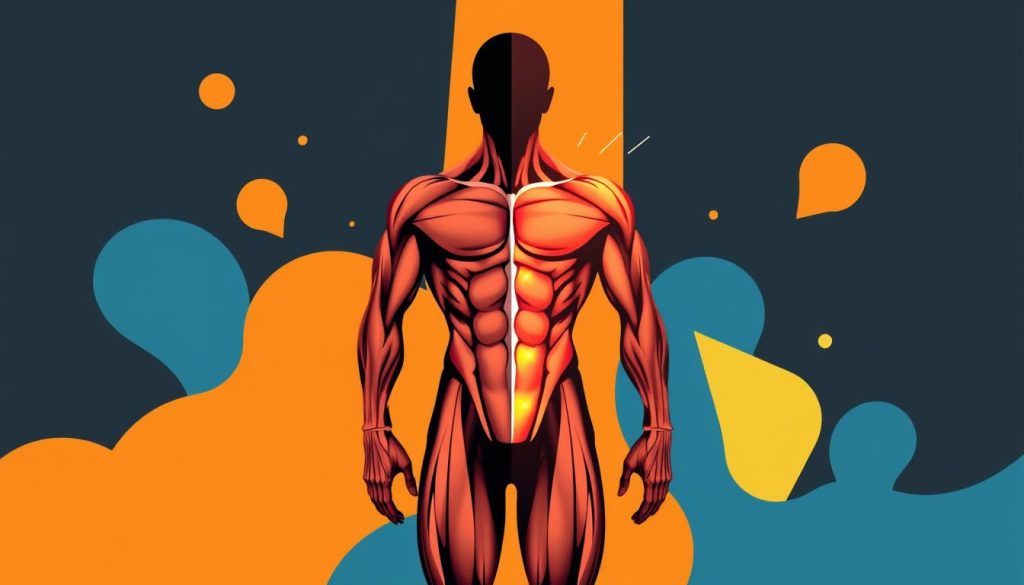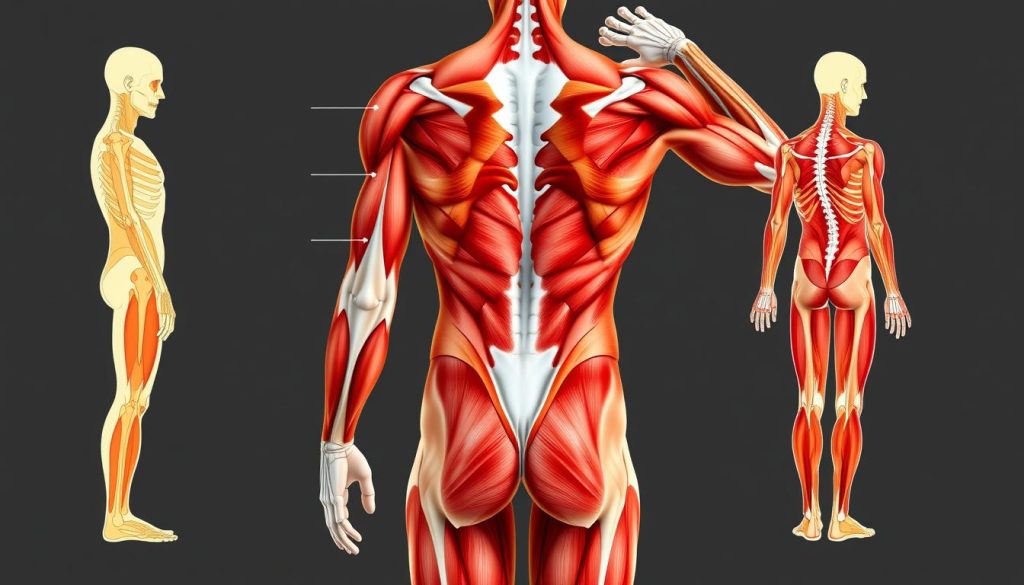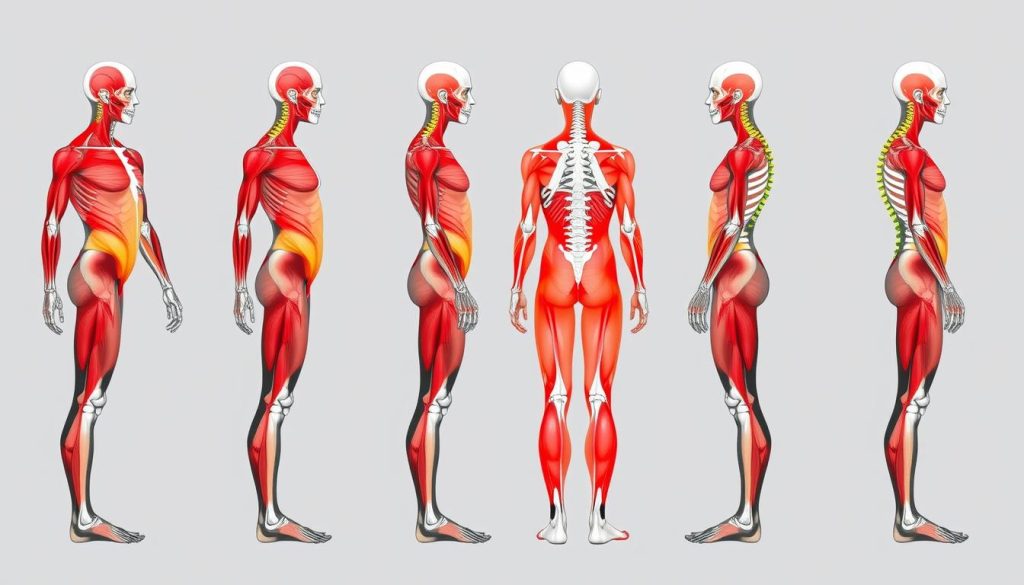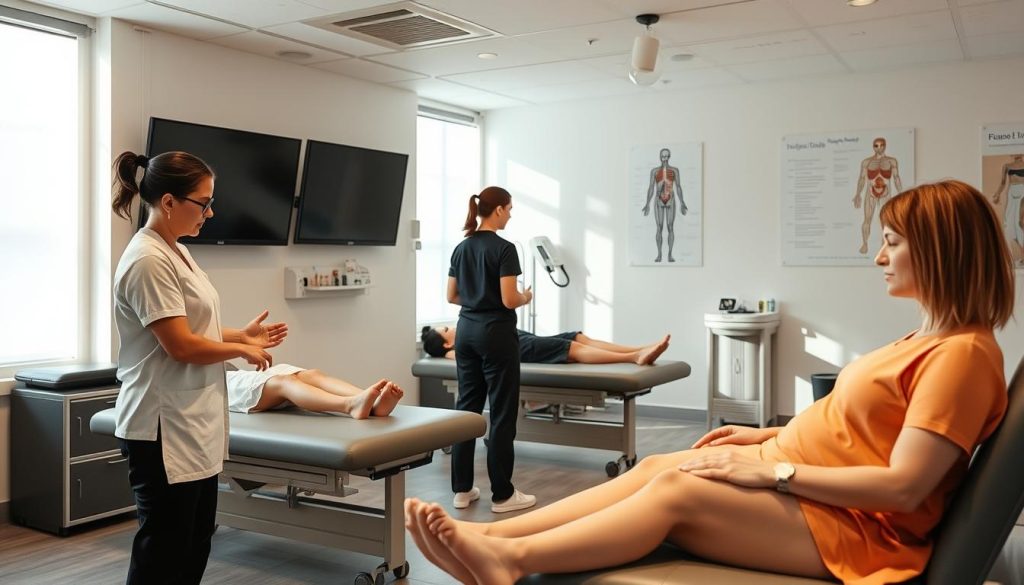Athletes and fitness fans often miss a key part of staying healthy: muscle imbalances. These small issues can greatly raise the risk of getting hurt. Riverside Sports Therapy knows how these imbalances can quietly harm your body’s performance and health.
When some muscles get stronger or tighter than others, it messes up how our body moves. This unevenness puts stress on certain areas, leading to chronic pain, less mobility, and injuries. It’s important to understand how muscle imbalances cause injuries to stay healthy.
At Riverside Sports Therapy, our team is great at finding and fixing these muscle imbalances. We do detailed checks and create special plans to stop injuries and boost physical performance. For help, call our team at (403) 283-7551.
Key Takeaways
- Muscle imbalances can significantly increase injury risks
- Uneven muscle development disrupts natural movement patterns
- Professional assessment is key for spotting issues
- Special treatments can stop long-term health problems
- Acting early keeps your body in top shape
Understanding Muscle Imbalances: A Complete Overview
Muscle imbalances are small but important problems in our muscles. They can really affect how well we move and our health. These issues come from how strong or flexible our muscles are and how our body moves.
Our bodies need all muscles to work together for simple actions. If some muscles are too strong or weak, it can cause problems.
Types of Muscle Imbalances
- Strength Imbalances: Uneven muscle development between opposing muscle groups
- Length-Tension Imbalances: Muscles with inappropriate resting lengths
- Neuromuscular Imbalances: Disrupted communication between nerves and muscles
Common Signs and Symptoms
Spotting muscle imbalances early can stop bigger problems later. Look out for:
- Persistent muscle pain
- Reduced range of motion
- Postural abnormalities
- Uneven muscle tone
Impact on Daily Activities
Muscle imbalances can mess up simple tasks. Body mechanics get off track, leading to more strain and injury risks.
“Understanding your body’s muscular equilibrium is the first step toward preventing physical limitations.” – Sports Medicine Research Institute
|
Imbalance Type |
Primary Characteristics |
Potential Consequences |
|
Strength Imbalance |
Uneven muscle development |
Increased injury risk |
|
Length-Tension Imbalance |
Inappropriate muscle resting length |
Reduced flexibility |
|
Neuromuscular Imbalance |
Disrupted nerve-muscle communication |
Compromised movement patterns |
The Science Behind Muscle Strength Imbalance
Muscle strength imbalance is a complex issue that affects how our body moves. It happens when some muscles are much stronger or weaker than others. This imbalance can lead to problems in how we move and perform.
The human body needs balanced muscle strength to work well. When muscles are not evenly strong, it can cause many issues. These include:
- Altered movement patterns
- Increased joint stress
- Reduced proprioceptive awareness
- Potential compensation mechanisms
“Muscle balance is not just about strength, but about coordinated neural communication and muscular interaction.” – Sports Biomechanics Research Institute
Neurologically, muscle strength imbalances come from many sources. These include repetitive movements, sitting too much, and uneven training. Our nervous system adapts to these habits, making some muscles work more than others.
|
Muscle Group |
Potential Imbalance Impact |
Risk Level |
|
Quadriceps/Hamstrings |
Knee Joint Instability |
High |
|
Chest/Back Muscles |
Postural Misalignment |
Medium |
|
Core Stabilizers |
Lower Back Strain |
High |
Knowing how muscles work together helps us train better. It helps us avoid injuries and move more efficiently. This knowledge is key to improving our body mechanics.
Why Muscle Imbalances Lead to Injuries
Muscle imbalances are a silent threat to athletic performance and overall physical health. Understanding why these imbalances create injury risk factors is key to preventing long-term damage to your body.

Musculoskeletal systems are complex networks that need precise muscle coordination. When some muscle groups get stronger or weaker, the body’s natural biomechanics are disrupted.
Biomechanical Stress Points
Muscle imbalances create unique stress points in the body, increasing injury risks. These stress points develop when muscles work inefficiently, causing:
- Uneven weight distribution
- Increased joint pressure
- Reduced movement efficiency
Compensation Patterns
The human body is amazingly adaptable. When muscle imbalances occur, your body develops compensation patterns to keep functioning. These patterns might temporarily hide the issue but can cause more strain over time.
“Movement compensations are your body’s attempt to protect itself, but they often create more problems than they solve.” – Sports Medicine Research
Progressive Deterioration
Untreated muscle imbalances can lead to progressive deterioration. What starts as minor discomfort can turn into chronic pain, reduced mobility, and a higher risk of acute injuries.
To prevent injuries, individuals must recognize and address muscle imbalances. This can be done through targeted exercises, proper training techniques, and regular professional assessments.
Common Areas Affected by Muscle Imbalances
Muscle imbalances can cause big problems for how our body works. They affect many important parts of our muscles and bones. Knowing where these problems happen helps us avoid injuries and fix them right.

Our body is like a big team where one muscle imbalance can affect many parts. Some areas are more likely to have these issues.
- Lower Back: Weakened core muscles combined with tight hip flexors
- Shoulders: Overdeveloped chest muscles versus weak upper back muscles
- Hips: Tight hip flexors with weak gluteal muscles
- Knees: Quadriceps dominance without proper hamstring engagement
“Understanding muscle imbalances is key to preventing long-term musculoskeletal problems.” – Sports Medicine Research Institute
Looking at these common areas shows how muscles work together and how they can compensate for each other.
|
Body Area |
Typical Imbalance |
Potential Consequences |
|
Lower Back |
Weak Core Muscles |
Chronic Pain, Reduced Mobility |
|
Shoulders |
Chest Muscle Dominance |
Postural Dysfunction |
|
Hips |
Tight Hip Flexors |
Reduced Range of Motion |
|
Knees |
Quadriceps Overactivation |
Increased Injury Risk |
By finding and fixing muscle imbalances early, we can lower the risk of injuries in these key areas.
How Poor Posture Contributes to Muscle Imbalances
Poor posture often leads to muscle imbalances. This can make our body mechanics worse and raise the risk of injuries. Our daily habits shape our muscles in ways that might harm our health over time.

It’s important to understand how posture affects our muscles. We need to look at many lifestyle factors that affect how we stand and move.
Workplace Ergonomics: A Silent Threat
Modern offices can be tough on our posture. Sitting for long periods and using workstations that aren’t right can lead to muscle imbalances. This happens because:
- It causes uneven muscle tension
- Weakens muscles that keep us stable
- Makes our spine curve in unnatural ways
Technology Use and Postural Strain
Smartphones and computers can harm our posture. The tech neck problem shows how using devices a lot can mess up our natural alignment.
|
Device |
Potential Postural Impact |
Muscle Groups Affected |
|
Smartphone |
Forward Head Posture |
Neck, Shoulders, Upper Back |
|
Laptop |
Rounded Shoulders |
Chest, Trapezius, Rotator Cuff |
|
Desktop Computer |
Prolonged Sitting Strain |
Lower Back, Hip Flexors |
Sleep Positions: Unconscious Alignment
How we sleep affects our muscles. Sleeping in the wrong way can make muscle imbalances worse or cause new problems.
“Your body spends approximately one-third of life sleeping – make those hours count for muscle health.” – Orthopedic Specialists
Knowing about these posture challenges helps us take steps to avoid muscle imbalances. This protects our health for the long term.
Identifying Your Personal Muscle Imbalances
Finding muscle imbalances early can change the game for staying injury-free and performing well. It’s important to know your body’s movement patterns. This requires looking closely at yourself and getting help from experts.
Top athletes and fitness fans understand that muscle imbalances can quietly hold you back. These small issues often come from doing the same thing over and over, bad posture, or uneven workouts.
“Your body speaks volumes through movement – learning to listen is the first step to prevention.” – Sports Medicine Expert
Here are some ways to check for muscle imbalances on your own:
- Do a basic posture check in front of a mirror
- Look for uneven shoulder heights
- Check how far you can move your joints
- Compare how strong you are on both sides of your body
While checking yourself is helpful, a detailed check by a sports therapy pro is even better. They use advanced tools to find exactly where the imbalances are. Then, they create plans to fix them.
Functional movement screening spots patterns that could lead to injuries. Knowing these patterns lets you make a plan to fix them. This way, you can get your muscles balanced and improve how well you move.
The Role of Movement Patterns in Injury Prevention
Understanding how our bodies move is key to avoiding injuries and keeping muscles stable. Athletes and fitness lovers can lower their injury risk by checking how they move during activities.

Professional sports therapists use special tests to check how well someone moves. These tests find weak spots and patterns that might cause injuries later.
Functional Movement Screening
Functional movement screening checks how well someone moves. It looks at:
- Basic movement patterns
- Muscle stability
- Potential injury risks
- How efficient movement is
“Movement quality is the foundation of injury prevention and athletic performance.” – Sports Medicine Expert
Movement Quality Assessment
A detailed check of movement quality shows what’s strong and weak in our bodies. Experts use set tests to look at:
- Joint flexibility
- Muscle coordination
- Balance and how our body feels its position
- How nerves and muscles work together
Knowing these important points helps athletes and fitness fans create plans to better their movement. This can lower their chance of getting hurt.
Effective Strategies for Correcting Muscle Imbalances
Fixing muscle imbalances needs a smart plan, not just regular workouts. Athletes and fitness fans must see that muscle stability is more than just being strong. It’s about making the body’s muscles work together in harmony.
“Balance is not something you find, it’s something you create” – Unknown
There are several important steps to fix muscle imbalances:
- Comprehensive movement screening
- Neuromuscular re-education
- Specialized strength training
- Flexibility and mobility work
To avoid injuries, a wide-ranging method is best. It tackles both weak and tight muscles. This means spotting bad movement habits and making plans to fix them.
|
Technique |
Primary Focus |
Expected Outcome |
|
Isolated Muscle Activation |
Weak Muscle Groups |
Improved Muscle Recruitment |
|
Soft Tissue Release |
Overactive Muscles |
Reduced Tension |
|
Corrective Exercises |
Movement Pattern Restoration |
Enhanced Functional Movement |
Using these methods takes time and care. Regular use of specific exercises can greatly improve muscle balance and lower injury chances.
Professional Treatment Options at Riverside Sports Therapy
Athletes and others looking for muscle imbalance solutions can get expert help at Riverside Sports Therapy. We focus on fixing muscle imbalances with personalized plans. These plans help prevent injuries and improve how you move.

Comprehensive Treatment Services
Our clinic has many services to meet your needs:
- Advanced physical therapy assessments
- Manual therapy techniques
- Customized exercise rehabilitation programs
- Functional movement pattern analysis
- Biomechanical screening
Innovative Treatment Approaches
Riverside Sports Therapy uses the latest methods to fix muscle imbalances. We combine hands-on treatments with education. This helps patients understand and help with their recovery.
“Our goal is not just treating symptoms, but identifying and addressing root causes of muscle imbalances.” – Riverside Sports Therapy Clinical Team
|
Treatment Service |
Focus Area |
Duration |
|
Identifying Imbalance Patterns |
60-90 minutes |
|
|
Manual Therapy Session |
Muscle Tension Release |
45-60 minutes |
|
Rehabilitation Program |
Corrective Exercise Training |
Multiple Sessions |
Ready to start your journey towards optimal muscle balance? Contact Riverside Sports Therapy at (403) 283-7551 to schedule your assessment today!
Creating a Balanced Exercise Program
Creating a full exercise program is key to avoiding injuries and keeping muscles stable. Athletes and those who work out need to make plans that cover all movement patterns. This helps keep the body balanced.
- Strength training for muscle growth
- Flexibility work to better range of motion
- Cardiovascular conditioning
- Specific muscle stability exercises
“Balance is not something you find, it’s something you create” – Unknown Fitness Coach
Progressing in your exercises is vital to avoid injuries. It keeps the body challenged while keeping muscles in line. The goal is to use varied movements that work many muscles at once.
|
Exercise Type |
Focus |
Recommended Frequency |
|
Strength Training |
Muscle Stability |
2-3 times per week |
|
Flexibility Work |
Range of Motion |
Daily stretching |
|
Cardiovascular Exercise |
Endurance |
3-5 times per week |
By mixing different exercises that test various movement patterns, you can build a strong fitness plan. This plan supports long-term muscle health and lowers injury risk.
Lifestyle Modifications to Maintain Muscle Balance
Maintaining muscle balance is more than just exercising sometimes. It starts with knowing how your body works and making smart daily choices. These choices help keep your muscles healthy.
Changing your lifestyle can really help avoid muscle imbalances. It’s about making sure all your muscles work together well. This is done through daily habits that focus on balance.
- Implement ergonomic workstation setups
- Practice regular movement breaks
- Use proper posture techniques
- Develop consistent stretching routines
“Small daily adjustments create substantial long-term muscle health improvements.” – Sports Medicine Research Institute
What you eat is also important for muscle balance. Eating the right proteins, anti-inflammatory foods, and staying hydrated helps your muscles recover. This prevents imbalances.
|
Lifestyle Factor |
Impact on Muscle Balance |
|
Sleep Position |
Reduces spinal misalignment |
|
Hydration |
Supports muscle flexibility |
|
Regular Movement |
Prevents muscle stiffness |
Being aware and taking action every day is essential for keeping your muscles balanced. It also helps prevent injuries.
Prevention Strategies for Long-term Success
To keep muscles balanced, you need a proactive plan. This plan should include regular maintenance to avoid muscle imbalances and injuries.
For lasting muscle health, you need a detailed strategy. It should cover functional movements and your personal physical needs.
Daily Maintenance Exercises
Creating a daily routine with specific exercises can fight muscle imbalances early. Important steps include:
- Core stabilization exercises
- Dynamic stretching routines
- Mobility work targeting specific muscle groups
- Proprioceptive training
Regular Assessment Schedule
Regular checks with professionals are key to keeping muscles balanced and preventing injuries. A good plan includes:
|
Frequency |
Assessment Type |
Focus Areas |
|
Every 3 months |
Functional Movement Screening |
Overall movement quality |
|
Every 6 months |
Comprehensive Muscle Balance Test |
Strength and flexibility |
|
Annually |
Advanced Biomechanical Analysis |
Detailed movement patterns |
“Prevention is always more effective than correction in maintaining optimal muscle health.” – Sports Medicine Research Institute
By using these prevention methods, you can build a lasting plan for muscle balance. This plan supports your long-term health and lowers injury risks.
Conclusion
Muscle imbalances are more than just a physical challenge. They are a key part of overall wellness. They affect how well we perform and how likely we are to get hurt.
At Riverside Sports Therapy, we have special ways to fix muscle imbalances. This helps people get back to their best and lowers the chance of getting hurt. Our team knows that everyone’s body is different. So, we tailor our help to fit each person’s needs.
Preventing injuries means looking at physical health in a big way. It doesn’t matter if you’re an athlete, office worker, or someone with ongoing pain. Knowing your body’s muscle patterns can lead to better movement, strength, and health. Come see how our therapists can help you.
Want to improve your physical health? Call Riverside Sports Therapy at (403) 283-7551 for a detailed muscle balance check. Start your path to a stronger, more durable body today.
For more details, visit: https://www.riversidesportstherapy.com/calgary-contact/
